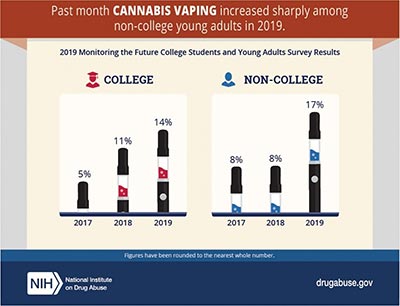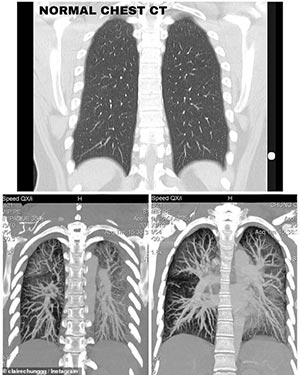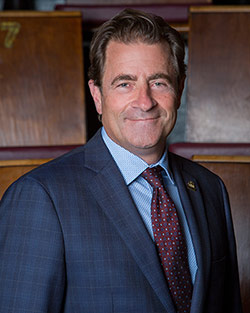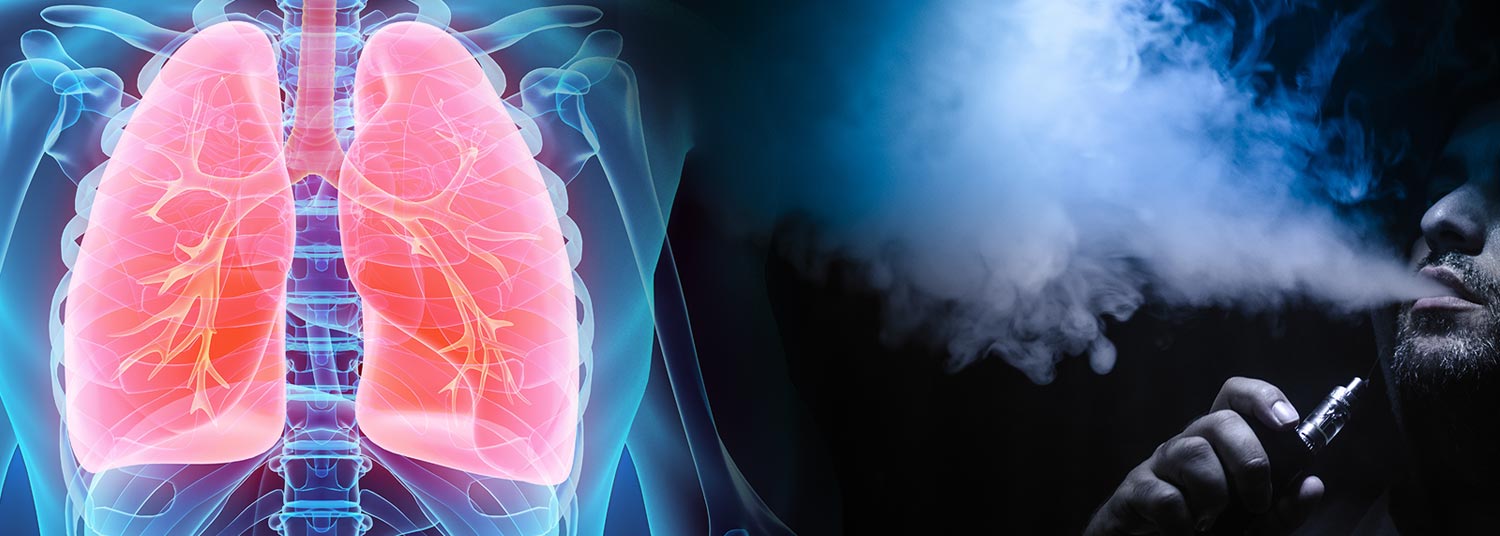January 23, 2023 | Deborah Kotz
Review Addresses 2019 Lung Injury Outbreak Caused by Contaminant in E-Cigarettes
 Nearly four years ago, federal health officials reported on a frightening new epidemic linked to e-cigarette use that caused a life-threatening and potentially irreversible lung condition. The condition – called e-cigarette or vaping product use-associated lung injury (EVALI) – was primarily linked to the inclusion of vitamin E acetate (VEA) in e-liquids used in vape cartridges. It was mainly found in marijuana vape products that were unregulated.
Nearly four years ago, federal health officials reported on a frightening new epidemic linked to e-cigarette use that caused a life-threatening and potentially irreversible lung condition. The condition – called e-cigarette or vaping product use-associated lung injury (EVALI) – was primarily linked to the inclusion of vitamin E acetate (VEA) in e-liquids used in vape cartridges. It was mainly found in marijuana vape products that were unregulated.
Jason Rose, MD, MBA, Associate Professor of Medicine and Associate Dean of Innovation and Physician Science Development at the University of Maryland School of Medicine (UMSOM), co-led a workshop through the American Thoracic Society that brought together public health experts from across the country to discuss the investigation findings and research on EVALI and to draft recommendations to help prevent future epidemics. Their analysis was published in a new report in the January 2023 issue of the Annals of the American Thoracic Society.
“We’re trying to raise awareness of this as a growing public health concern,” said Dr. Rose. “We’ve identified and managed the VEA problem, but there are likely going to be new substances and contaminants present in e-liquid formulations that can induce lung injuries in the future.”
There has been an increase in e-cigarette use over the years as some adults use these nicotine products to help them quit smoking. What has been alarming, however, is the rise in vaping among teens and young adults who are using these products for recreational purposes. In a federally funded 2019 survey, 22 percent of college students said they vaped nicotine in the past month, more than double the percentage of those who reported vaping in a 2017 survey. The percentage of college students who said they vaped marijuana in the past 30 days rose from 5 percent in 2017 to 14 percent in 2019, according to the National Institute on Drug Abuse. Similar rates and a similar rate increase were also seen in young adults who were not attending college.
 The 2019 EVALI epidemic caused 2,807 hospitalizations and 68 deaths in the U.S. before VEA was identified and removed from e-cigarette products, according to the new analysis. Symptoms of EVALI mimicked an acute respiratory illness with symptoms such as cough, shortness of breath, chest pain, and, in some cases, coughing up blood. Gastrointestinal symptoms, fever, fatigue, or rapid weight loss were also associated with EVALI.
The 2019 EVALI epidemic caused 2,807 hospitalizations and 68 deaths in the U.S. before VEA was identified and removed from e-cigarette products, according to the new analysis. Symptoms of EVALI mimicked an acute respiratory illness with symptoms such as cough, shortness of breath, chest pain, and, in some cases, coughing up blood. Gastrointestinal symptoms, fever, fatigue, or rapid weight loss were also associated with EVALI.
“At its core, EVALI is a serious disease that primarily affects the lungs and results in a substantial number of hospitalizations and deaths in a relatively young and otherwise healthy population across the United States,” said study co-leader Meghan Rebuli, PhD, assistant professor in the Department of Pediatrics in the UNC School of Medicine. “This epidemic is largely caused by the unregulated and quickly evolving nature of the e-cigarette industry and certainly highlights the need for continued action by both researchers and government agencies.”
 Early in the epidemic, the Centers for Disease Control and Prevention (CDC) took e-cigarette samples to identify what EVALI patients were breathing into their respiratory systems. Tetrahydrocannabinol (THC) – the psychoactive ingredient in marijuana – and vitamin E acetate were found in the majority of samples; this led the CDC to conclude that vitamin E acetate was likely responsible for causing EVALI. Vitamin E acetate, however, wasn’t found in all the vaping products linked to EVALI cases, which raises the question of whether other components also may have led to the lung condition, according to Dr. Rose.
Early in the epidemic, the Centers for Disease Control and Prevention (CDC) took e-cigarette samples to identify what EVALI patients were breathing into their respiratory systems. Tetrahydrocannabinol (THC) – the psychoactive ingredient in marijuana – and vitamin E acetate were found in the majority of samples; this led the CDC to conclude that vitamin E acetate was likely responsible for causing EVALI. Vitamin E acetate, however, wasn’t found in all the vaping products linked to EVALI cases, which raises the question of whether other components also may have led to the lung condition, according to Dr. Rose.
The workshop panel issued several public health recommendations to prevent such outbreaks in the future. First and foremost, the panel underscored the need for scientists to understand the mechanisms of EVALI more fully. More study is needed, for example, to assess the role played by various compounds in vaping products on the development of lung disease. This step would require more research and testing of e-liquid formulations to determine their toxicity (based on dose and delivery through inhalation) with the goal of categorizing the ingredients to create safety standards. The workshop panel advised less restrictive regulations on the study of marijuana – currently considered a controlled substance by the federal government –to allow for more robust studies of THC in vaping products.
 “Healthcare providers need to be better educated on the signs and symptoms of EVALI to quickly recognize the condition and identify new outbreaks,” said UMSOM Dean Mark T. Gladwin, MD, Vice President for Medical Affairs, University of Maryland, Baltimore, and the John Z. and Akiko K. Bowers Distinguished Professor. “Just as important, though, is the need to inform consumers through public health messaging of the potential dangers of vaping products that are largely unregulated and have unknown health risks.”
“Healthcare providers need to be better educated on the signs and symptoms of EVALI to quickly recognize the condition and identify new outbreaks,” said UMSOM Dean Mark T. Gladwin, MD, Vice President for Medical Affairs, University of Maryland, Baltimore, and the John Z. and Akiko K. Bowers Distinguished Professor. “Just as important, though, is the need to inform consumers through public health messaging of the potential dangers of vaping products that are largely unregulated and have unknown health risks.”
About the University of Maryland School of Medicine
Now in its third century, the University of Maryland School of Medicine was chartered in 1807 as the first public medical school in the United States. It continues today as one of the fastest growing, top-tier biomedical research enterprises in the world -- with 46 academic departments, centers, institutes, and programs, and a faculty of more than 3,000 physicians, scientists, and allied health professionals, including members of the National Academy of Medicine and the National Academy of Sciences, and a distinguished two-time winner of the Albert E. Lasker Award in Medical Research. With an operating budget of more than $1.3 billion, the School of Medicine works closely in partnership with the University of Maryland Medical Center and Medical System to provide research-intensive, academic, and clinically based care for nearly 2 million patients each year. The School of Medicine has nearly $600 million in extramural funding, with most of its academic departments highly ranked among all medical schools in the nation in research funding. As one of the seven professional schools that make up the University of Maryland, Baltimore campus, the School of Medicine has a total population of nearly 9,000 faculty and staff, including 2,500 students, trainees, residents, and fellows. The combined School of Medicine and Medical System (“University of Maryland Medicine”) has an annual budget of over $6 billion and an economic impact of nearly $20 billion on the state and local community. The School of Medicine, which ranks as the 8th highest among public medical schools in research productivity (according to the Association of American Medical Colleges profile) is an innovator in translational medicine, with 606 active patents and 52 start-up companies. In the latest U.S. News & World Report ranking of the Best Medical Schools, published in 2021, the UM School of Medicine is ranked #9 among the 92 public medical schools in the U.S., and in the top 15 percent (#27) of all 192 public and private U.S. medical schools. The School of Medicine works locally, nationally, and globally, with research and treatment facilities in 36 countries around the world. Visit medschool.umaryland.edu
Contact
Deborah Kotz
Senior Director of Media Relations
Office of Public Affairs & Communications
University of Maryland School of Medicine
Email: DKotz@som.umaryland.edu
o: 410-706-4255
c: 410-804-0054
t: @debkotz2
Related stories

Tuesday, November 21, 2023
University of Maryland, Baltimore Receives Landmark Funding to Create New Innovation Hub in West Baltimore and the Region
University of Maryland, Baltimore (UMB) President Bruce Jarrell, MD, FACS, and University of Maryland School of Medicine (UMSOM) Dean Mark Gladwin, MD, announced today that the University has received a four-year, $4 million Research Evaluation and Commercialization Hubs (REACH) grant from the National Institutes of Health (NIH) to support the University’s work advancing the biomedical entrepreneurship and innovation economy in West Baltimore and Greater Baltimore while also training one of the most diverse biomedical and entrepreneurial workforces in the country.

Thursday, October 06, 2022
Dr. Jason Rose Appointed Associate Dean for Innovation and Physician Science Development
University of Maryland School of Medicine (UMSOM) Dean Mark T. Gladwin, MD announced today that Jason Rose, MD, MBA, has been named Associate Dean for Innovation and Physician Science Development at UMSOM. He will also serve as the Director of Faculty Entrepreneurship. The new positions are part of Dean Gladwin’s goal of strengthening the school’s physician-scientist pipeline and advancing a major effort to foster biomedical start-up companies that are based in academia.

